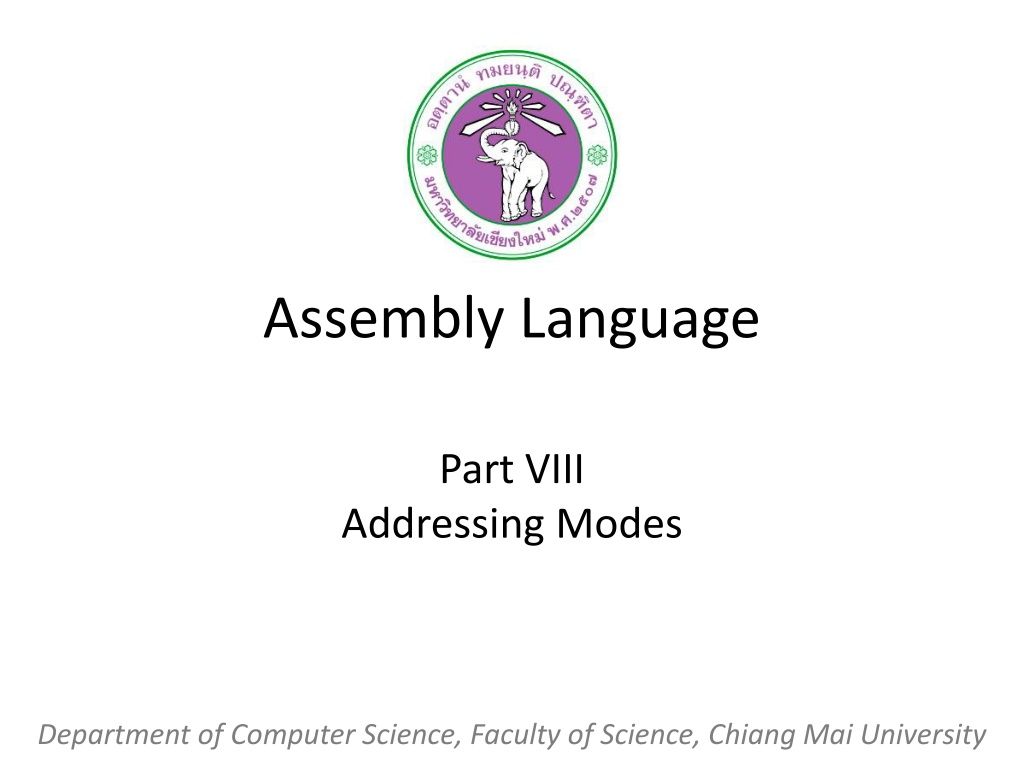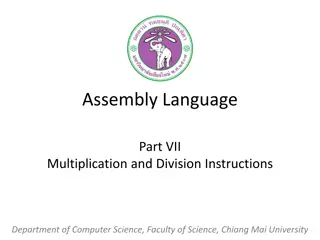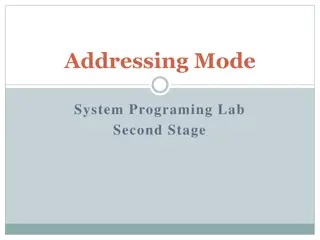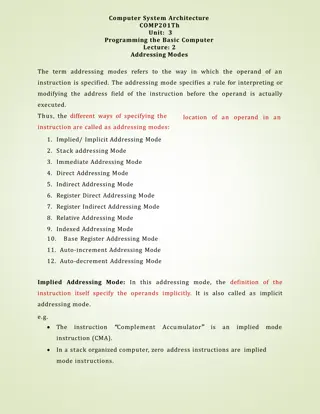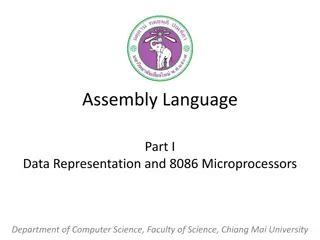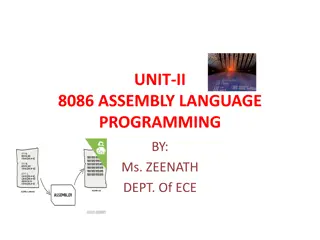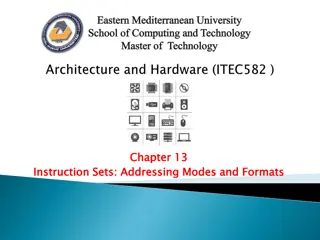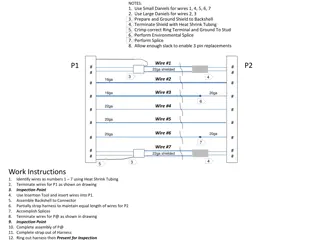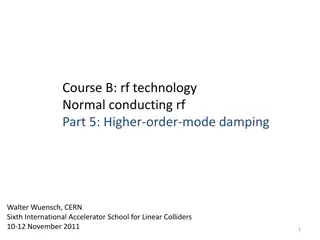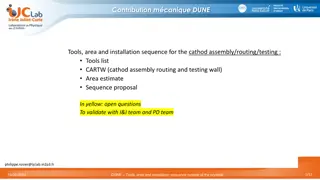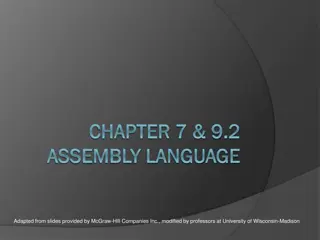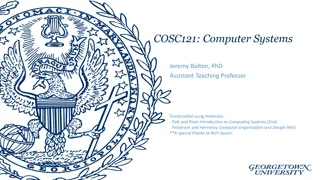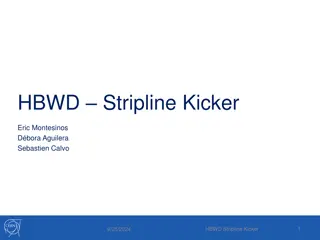Understanding Addressing Modes in Assembly Language
This content delves into the intricacies of addressing modes in assembly language, covering topics such as one-dimensional arrays, the DUP operator for defining arrays, and various modes like register, immediate, direct, and register-indirect modes. It explains how operands are specified in different modes and provides practical examples for better comprehension.
Download Presentation

Please find below an Image/Link to download the presentation.
The content on the website is provided AS IS for your information and personal use only. It may not be sold, licensed, or shared on other websites without obtaining consent from the author. Download presentation by click this link. If you encounter any issues during the download, it is possible that the publisher has removed the file from their server.
E N D
Presentation Transcript
Assembly Language Part VIII Addressing Modes Department of Computer Science, Faculty of Science, Chiang Mai University
Outline One-Dimensional Arrays Addressing Modes Two-Dimensional Arrays Based Indexed Addressing Mode 2 204231: Computer Organization and Architecture
One-Dimensional Array A 3 204231: Computer Organization and Architecture
The DUP Operator The DUP (duplicate) is used to define arrays whose elements share a common initial value. repeat_count DUP (value) GAMMADW 100 DUP (0) DELTA DB 212 DUP (?) LINE DB 5, 4, 3 DUP (2, 3 DUP (0), 1) LINE DB 5,4,2,0,0,0,1,2,0,0,0,1,2,0,0,0,1 4 204231: Computer Organization and Architecture
One-Dimensional Array A W DW 10, 20, 30, 40, 50, 60 Offset address 0200h 0202h 0204h 0206h 0208h 020Ah Symbolic address Decimal address W W + 2h W + 4h W + 6h W + 8h W + Ah 10 20 30 40 50 60 5 204231: Computer Organization and Architecture
Addressing Modes The way an operand is specified register mode: an operand is a register. immediate mode: an operand is a constant. direct mode: an operand is a variable. MOV AX, 0 ADD ALPHA, AX 6 204231: Computer Organization and Architecture
Register Indirect Mode [register] The register is BX, SI, DI, or BP. For BX, SI, or DI, the operand s segment number is contained in DS. For BP, SS has the segment number. 7 204231: Computer Organization and Architecture
Suppose that SI contains 0100h, and the word at 0100h contains 1234h. MOV The CPU 1. examines SI and obtains the offset address 100h, 2. uses the address DS:0100h to obtain the value 1234h, and 3. moves 1234h to AX. MOV AX, SI ; AX = 0100h AX, [SI] ; AX = 1234h 8 204231: Computer Organization and Architecture
Suppose that BX contains 1000h SI contains 2000h DI contains 3000h Offset 1000h contains 1BACh Offset 2000h contains 20FEh Offset 3000h contains 031Dh where the above offsets are in the data segment addressed by DS. 9 204231: Computer Organization and Architecture
Tell which of the following instructions are legal. If legal, give the source offset address and the result or number moved. Source offset a. MOV BX, [BX] 1000h b. MOV CX, [SI] 2000h c. MOV BX, [AX] illegal source register d. ADD [SI], [DI] illegal memory-memory addition e. INC [DI] 3000h Result 1BACh 20FEh 031Eh 10 204231: Computer Organization and Architecture
Write some code to sum in AX the elements of the 10-element array W defined by W DW 10,20,30,40,50,60,70,80,90,100 11 204231: Computer Organization and Architecture
The idea is to set a pointer to the base of the array, and let it move up the array, summing elements as it goes. XOR AX, AX LEA SI, W MOV CX, 10 ADDNOS: ADD AX, [SI] ADD SI, 2 ; AX holds sum ; SI points to array W ; CX has number of elements ; sum = sum + element ; move pointer to ; the next element ; loop until done LOOP ADDNOS 12 204231: Computer Organization and Architecture
Based and Indexed Addressing Mode [register + displacement] [displacement + register] [register] + displacement displacement + [register] displacement[register] based: BX(base register) or BP (base pointer) indexed: SI (source index) orDI (destination index) 13 204231: Computer Organization and Architecture
Based and Indexed Addressing Mode MOV MOV MOV MOV MOV AX, W[BX] AX, [W + BX] AX, [BX + W] AX, W + [BX] AX, [BX] + W 14 204231: Computer Organization and Architecture
Rework the last example by using based mode. XOR AX, AX XOR BX, BX MOV CX, 10 ADDNOS: ADD AX, W[BX] ADD BX, 2 LOOP ADDNOS ; AX holds sum ; clear base register ; CX has number of elements ; sum = sum + element ; index next element ; loop until done 15 204231: Computer Organization and Architecture
Suppose that ALPHA is declared as ALPHA DW 0123H, 0456h, 0789h, 0ABCDh in the segment addressed by DS. Suppose also that BX contains 2 SI contains 4 DI contains 1 Offset 0002 contains 1084h Offset 0004 contains 2BACh 16 204231: Computer Organization and Architecture
Tell which of the following instructions are legal. If legal, give the source offset address and the result or number moved. Source offset Number moved ALPHA+2 0456h 2+2 = 4 2BACh ALPHA+4 0789h 2+4 = 2 1084h 0789h Illegal form of source operand Illegal source register a. b. c. d. e. f. g. MOV AX, [ALPHA+BX] MOV BX, [BX+2] MOV CX, ALPHA[SI] MOV AX, 2[SI] MOV BX, [ALPHA+3+DI] ALPHA+4 MOV AX, [BX] 2 ADD BX, [ALPHA+AX] 17 204231: Computer Organization and Architecture
Two-Dimensional Array B 18 204231: Computer Organization and Architecture
Row-Major Order B DW 10, 20, 30, 40 DW 50, 60, 70, 80 DW 90, 100, 110, 120 19 204231: Computer Organization and Architecture
Column-Major Order B DW 10, 50, 90 DW 20, 60, 100 DW 30, 70, 110 DW 40, 80, 120 20 204231: Computer Organization and Architecture
Based Indexed Addressing Mode variable [base_register][index_register] [base_register + index_register + variable + constant] variable [base_register + index_register + constant] constant [base_register + index_register + variable] 21 204231: Computer Organization and Architecture
Based Indexed Addressing Mode MOV MOV MOV AX, W[BX][SI] AX, [W + BX + SI] AX, W[BX + SI] 22 204231: Computer Organization and Architecture
An application: Average Test Scores sum[j] = 0 i = 1 FOR 5 times DO sum[j] = sum[j] + score[i, j] i = i + 1 END_FOR 23 204231: Computer Organization and Architecture
Reference Ytha Yu and Charles Marut, Assembly Language Programming and Organization of the IBM PC. New York: McGraw-Hill, 1992. 24 204231: Computer Organization and Architecture
